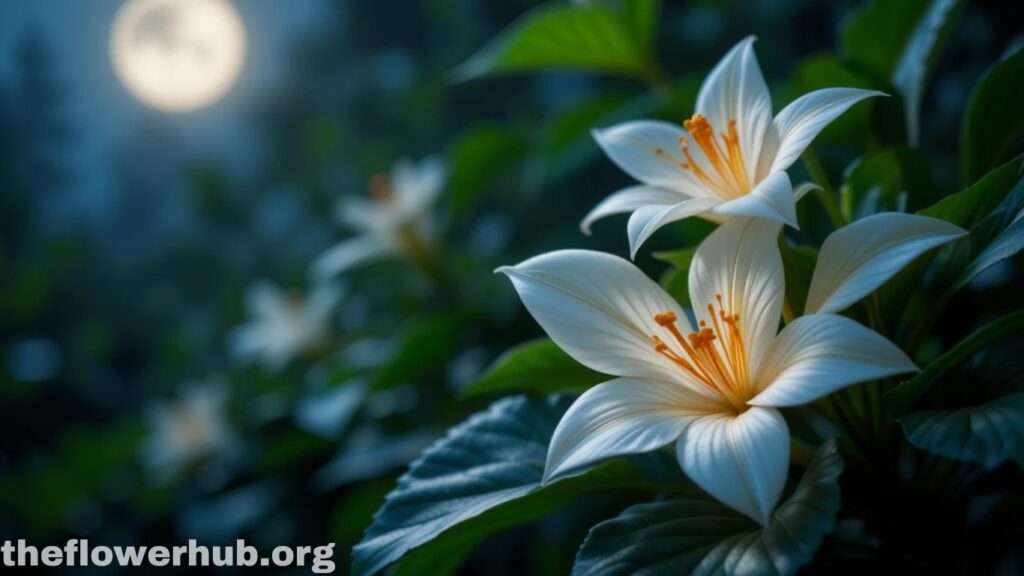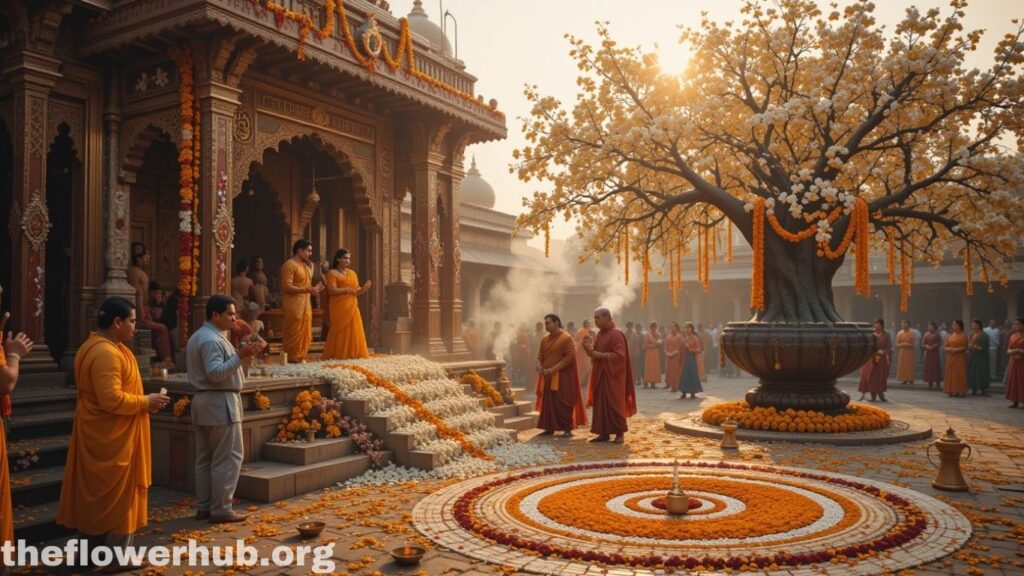Introduction
The pRijAta flower (also called Night flowering Jasmine or harsinagR) one of the most mystical and sacred flowers in Indian mythology and ancient scriptures. Its lovely white petals with orange-red stem exude a fragrance that is very fragrant, especially at night, making it a beautiful and very special symbol for the Hindus.
In this comprehensive post, we do a deep dive into the Parijat flower from a number of perspectives — mythological significance, botanical characteristics, spiritual significance, health uses, how it is grown and its relevance in these times. If you love outdoor gardening or if you are a spiritual person then this blog will open your mind to the hidden truths and beneficial wisdom in relation to this sacred flower.

Table of Contents
Table: Overview
| Attribute | Details |
|---|---|
| Botanical Name | Nyctanthes arbor-tristis |
| Common Names | Parijata, Harsingar, Night Jasmine |
| Origin | India and Southeast Asia |
| Family | Oleaceae |
| Flowering Season | Monsoon to early winter |
| Flower Colour | White petals and between them orange stalks |
| Fragrance | Strong, sweet, and pleasant |
| Cultural Significance | Hindu mythology and Ayurveda |
| Life Span | Deciduous shrub/tree (5–10 years) |
| Medicinal Uses | Anti-inflammatory, antifungal |
Parijata Flower and the Divine Provenance
Mythology behind
In Hindu mythology, the Parijata flower rose par culmination of the churning from the ocean (Sagar Manthan). It was one of the five sacred treasures offered to the gods. Lord Indra would plant this in his celestial garden where it was known as a source of heavenly beauty and longevity.
In the Mahabharata, there is a well-known legend of Lord Krishna, Satyabhama and Rukmini, around the Parijata tree. Krishna brought Parijata from Devlok to make his beloved wife Satyabhama happy. But that went into blossom only in the courtyard of Rukmini, indicating that genuine love cannot be meddled with.
Botanical Details and Growth Habits
The True Form of the Parijata Creeper
The Parijata flower is from a small bearing deciduous tree or shrub that grows to 10-15 feet. It is native to tropical and subtropical regions, and it grows best in well-drained soil and partial sun.
How to Recognize the Parijata Flower
- Leaves: Opposite, rough-textured, and ovate.
- Flowers: White with orange tubular base.
- Bark: Gray with exfoliating plates.
Growing and Caring
Parijata Flower Cultivation Guide
Growing the Parijata plant is very rewarding, fragrant and sacred component. Here is best how to grow it:
Best Climate and Location
- Light: Partial shade/full sun.
- Temperature: Thrives between 15°C–30°C.
- Humidity: Prefers moderate humidity.
Soil Requirements
- Use well-draining loamy soil.
- Soil pH should be between 6.5-7.5.
Watering & Fertilization
- Water moderately — avoid waterlogging.
- Feed once a month during growth season with organic compost or balanced npk.
Pruning Tips
- “Prune after flowering to promote bushier growth.
- Prune out dead branches and old flowers.
Medicinal and Ayurvedic Benefits
Healing properties of the Parijata flower
The Parijata is not just for prettiness, its Ayurvedic properties are sudden and potent.
Common Medicinal Uses
- Leaves: Used for fever, arthritis and sciatica.
- Flowers: in Aromatic Oils & Infusions to aid mental relaxation.
- Bark: Known for anti-parasitic properties.
Scientific Backing
Extracts of Nyctanthes arbor-tristis have been found to be antimicrobial, anti-inflammatory and antioxidant in studies. They are commonly found in formulations to and enhance immune function and aid in the reduction of inflammation.
Spiritual and Cultural Importance
Significance of Parijata Flower in Indian Customs
Parijata flower is used in many rituals and ceremonies in india and it has spiritual significance.
Symbol of Dedication and Enigma
Its flowers open at night and fall away before the night is out — an exquisite symbol of transience and selfless giving.
Use in Religious Offerings
- Distributed to Lord Vishnu, Lord Shiva and Goddess Lakshmi.
- Worn for occassions such as Diwali and Navratri.
In Literature and Art
From verse to temple stone, generations of artists and poets have been inspired by the fragrant offerings of the Parijata flower.
In Sanskrit Literature
- Found in old writings such as the Bhagavata Purana.
- Due to its falling flowers — a symbol of loss and beauty — it is often referred to as the “Tree of Sorrows.
In Classical Dance and Art
- It is shown in Bharatanatyam and Madhubani as well.
- Symbolizes femininity, purity, and surrender.
The Science Behind Its Fragrance
One Reason the Parijata Flower Has a Stronger Scent at Night
The Parijata blossom is most fragrant at night as a magical process called nocturnal volatilization takes place after sunset. Volatile compounds and essential oils such as benzyl acetate and linalool are activated during the night to attract pollinators like moths.
Parijata Flower Across Borders
Global Significance of the Parijata Compound
Also called the Night-Flowering Jasmine, it is native to South Asia and yet it has been the talking point elsewhere too, in places such as:
- Thailand – This is called Harsingar in the folk medicine.
- Sri Lanka – To be chanted during the worship in the temple.
- Caribbean Islands – Cultivated ornamental, less commonly cultivated.
Parijata Flower in Modern Landscaping
Considering its compact size and beautiful blooms, the Parijata flower has become a popular choice for home gardens, meditation retreat centers, and urban balconies.
Ideal For:
- Temple gardens
- Meditation centers
- Courtyard plantations
- Aromatherapy gardens
Sustainability and Ecological Role
In what way does the Parijata flower contribute to the environment
Pollinator-friendly: Yes (bees, night moths).
Soil Booster: Its fallen leaves and blooms break down quickly to improve the soil.
Low Water Requirement: It is eco-friendly and drought-tolerant.
Common Myths and Misconceptions
Debunking Myths About the Parijata Flower
| Myth | Reality |
|---|---|
| Can only be harvested in heaven | Falls under tropical zones, such as India and Nepal |
| Wants a lot of care | Really no-fuss once established |
| Once a year blooming | Several blooming from monsoon to winter |
Cultural Festivals Dedicated to the Parijat Flower

- Sharad Purnima: For worship and adoration.
- Karva Chauth: Represents reverence and fondness.
- Tulsi Vivah: Purity and spiritual connect.
FAQs
What is the metaphysical meaning of the Parijata flower?
The Parijata flower represents purity, offering and divine love. Such love is often referred to as devotion or spiritual awakening.
Can Parijata grow in pots?
Yes the plant can mature in large pots with good drainage and enough sunlight.
Can we pluck Parijata flowers?
Parijatas don’t pluck The broken flowers of Parijata are traditionally only used for religious rituals as plucking the flowers is said to displease the Gods.
How much do I water the plant?
Watering twice a week during dry periods, and once during monsoon.
Are Parijata flowers edible?
Extracts of this are used in Ayurdevic medicines, but seldom eaten. Do not use them without the advice of a specialist.
Conclusion
The Parijata flower is immortal symbol of beauty, spirituality and healing. With its significance in myths of old, calming scent, and vital healing qualities, it is more than just a beautiful plant — it is life itself; it is serenity; it is sacredness.
Whether you are planting it in your garden, giving it in a ritual, or using in wellness brings a divine feeling into the day. By learning how to appreciate and learn from many of its details, we rediscover nature, tradition, and the deeper dimensions of life.
